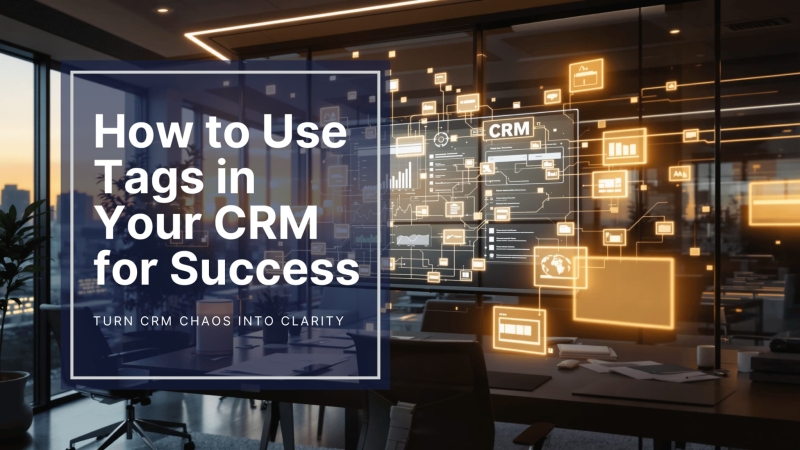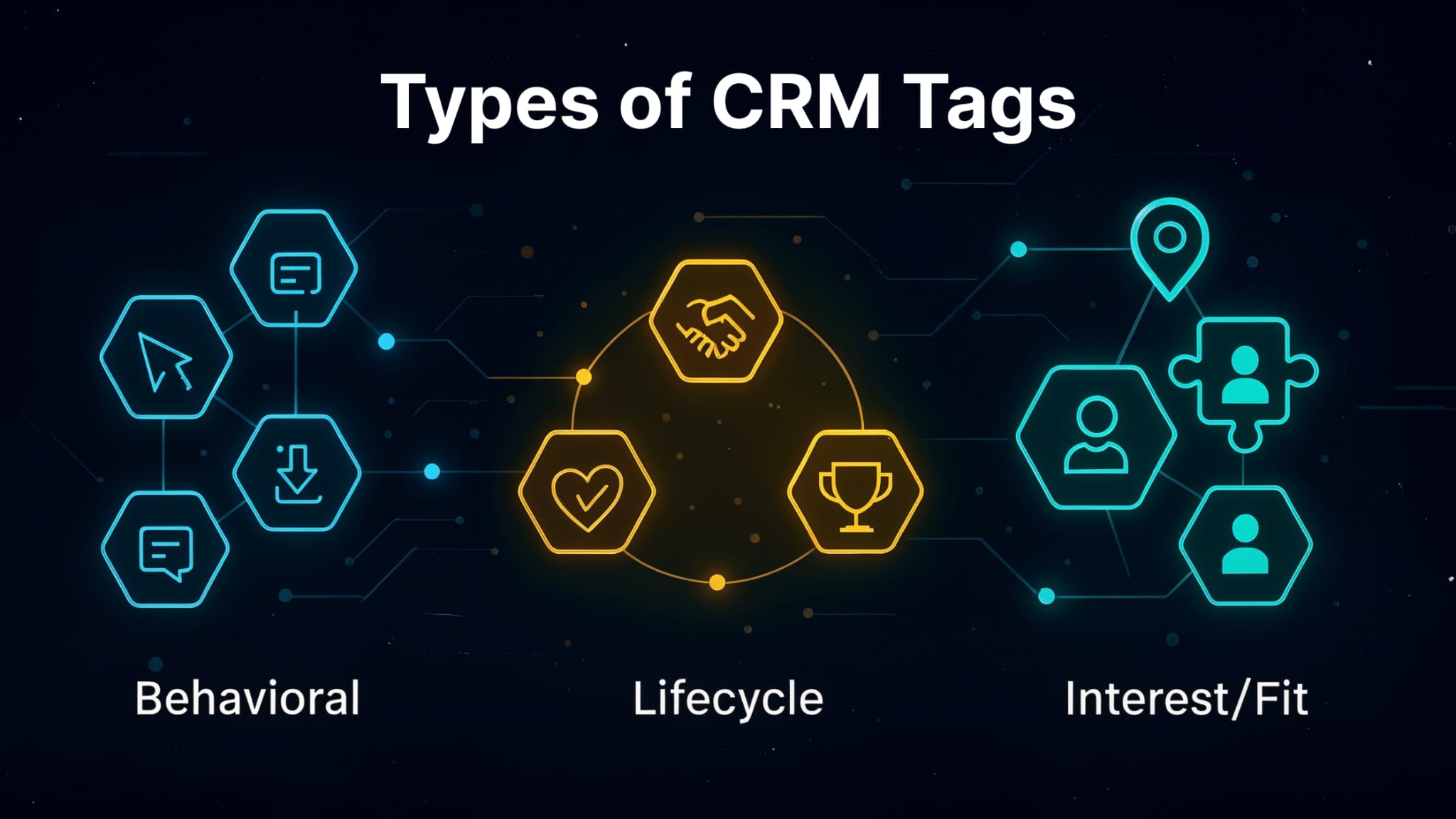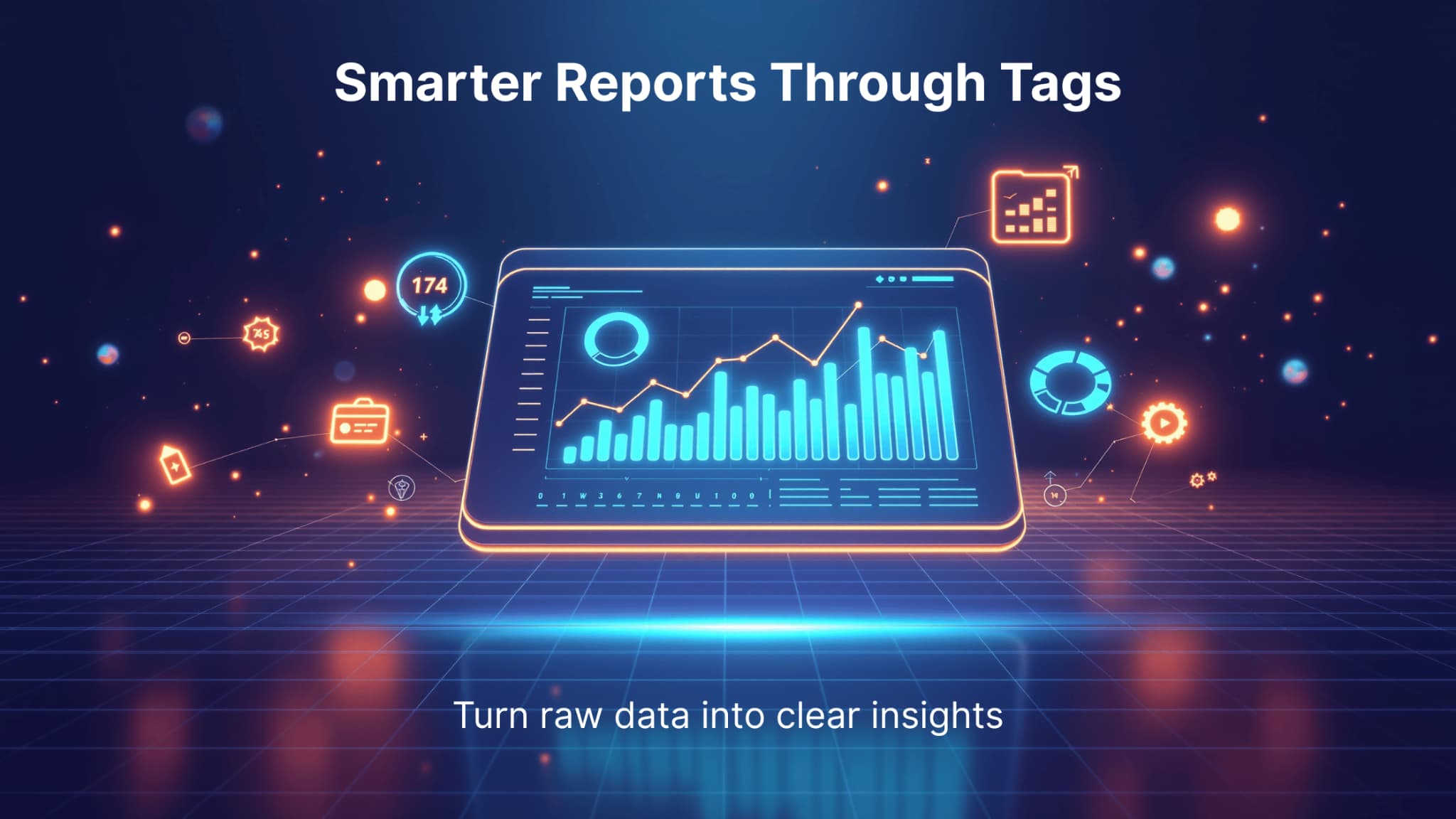How to Use Tags in Your CRM for Success
by

Let’s be real: tags aren’t flashy. They quietly work in the background, but when used well, they can completely change how your CRM feels to work in. Instead of a cluttered database that just holds information, your CRM starts acting like a helpful teammate that keeps things organized and running smoothly in the background.
We’ve seen this firsthand. One coaching firm increased webinar attendance by 65% by leveraging tags for auto segmentation. A local service company cut hours of admin work every week after tagging by city and service type. The company didn’t upgrade platforms or hire new staff; they just got smart with their tags.
This guide on how to use tags in your CRM is here to show you how to do the same. We’ll walk through how to use tags to stay organized, save time with automation, and make your CRM finally feel like it fits the way you work. Let’s dig in.

What Are CRM Tags (and Why They Matter)
You’ve probably seen tags before, maybe even used a few. They’re those quick labels you attach to contacts to help you keep things sorted. Unlike custom fields that require structure, tags are lightweight and flexible. You can quickly add them to contacts, filter by them, or use them to trigger actions.
Here’s what tags usually represent:
- Behavioral: What someone does, downloads a resource, attends a webinar, or asks for a quote.
- Lifecycle: new lead, active customer, returning client, VIP.
- Interest/Fit: What they care about, a specific service, product, or region.
| Tag Type | Purpose | Example |
|---|---|---|
|
Behavioral |
Track engagement or actions |
Webinar Attendee |
|
Lifecycle |
Show the customer journey stage |
Active Client |
|
Interest/Fit |
Segment based on traits |
Region: West Coast |
Here’s the simple truth: not every tag deserves to exist. If a tag doesn’t help you take action or learn something meaningful, it’s just digital clutter.
1. Segment Your Lists With Purpose
Segmentation is where tagging starts to shine. Instead of sending the same email to everyone, you can talk to people in ways that feel relevant and personal.
Smart ways to segment using tags:
- By interest: Products or services they’ve shown interest in.
- By engagement: Who’s opening emails, clicking links, or showing up to webinars.
- By source: Where the lead came from, a referral, ad, or event.
- By location: Useful if your business operates across local regions.
A landscaping company, for example, tags by property size so they can quote accurately. A consultant might tag by industry, “Coaching,” “SaaS,” or “Healthcare,” to tailor examples in their emails. Small effort, big impact.
If your CRM integrates with your marketing tools, let the tags do the work. Anyone tagged as a Webinar Attendee can automatically join a follow-up sequence without you lifting a finger. When your outreach feels personal instead of mass-produced, people notice.
Here’s a closer look at how you can leverage tags for a webinar event to better understand audience behavior and follow up more effectively. For example, you might use tags to track:
- Attended your event: Mark those who showed up so you can automatically add them to a post-webinar follow-up workflow that aligns with the goal of your webinar (book a meeting, purchase a product, etc.).
- Registered but did not attend: Follow up with a replay link to keep them engaged.
- Joined late: Understand how many people joined after a specific time to see if your reminders worked.
- Stayed for a certain amount of time: Measure engagement and interest levels.
- Saw your CTA but didn’t click: Send a softer reminder or different offer.
- Clicked your CTA: Follow up quickly with sales outreach or related offers.
- Purchased a product: Tag them as customers to avoid duplicate marketing efforts.
By tracking this data, you can clearly see which events and CTAs generate the most qualified leads and sales. It also helps you visualize how leads move through your funnel from initial signup to conversion, so you can refine future campaigns and nurture strategies.
Once segmentation is in place, it’s time to automate it so it runs itself.

2. Automate Tagging to Save Time
Manual tagging works when you have a dozen contacts, not thousands. Automation takes the grunt work out of it and keeps everything consistent.
Start simple:
- When someone fills out a form, apply tags for their interest or source.
- When a deal closes, remove the Prospect tag and add an Active Client tag.
- When a customer renews or buys again, add a Repeat Buyer tag.
Automation saves time, prevents errors, and ensures follow-ups happen automatically. Pulse data shows teams that automate basic tagging save roughly five hours per week, which is time that can be put toward selling or serving customers.
| Before Automation | After Automation | Time Saved |
|---|---|---|
|
Manually tagging leads |
Tags apply instantly via forms |
3–5 hrs/week |
|
Updating deal stages |
Tags update automatically |
2 hrs/week |
|
Forgetting follow-ups |
Tags trigger reminders |
Consistent outreach |
When automation handles the small stuff, you get back to the work that actually moves your business forward.

3. Use Tags to Make Reporting Smarter
Once tagging becomes consistent, your reports stop feeling like a pile of raw data and start revealing the real story behind your performance. Instead of guessing where growth comes from, you can actually see it.
Once you have actionable reports, you'll stop asking questions like these:
- Which sources bring in the most revenue?
- Which customers stick around the longest?
- Which campaigns are worth repeating?
These questions will be answered in real time by reports that reveal the insights you need to make smart business decisions and stop guessing what actually works.
| Tag Insight | Benefit | Example |
|---|---|---|
|
Source comparison |
Identify top-performing channels |
Paid Ads vs. Referrals |
|
Lifetime value |
See who brings long-term revenue |
VIP or Repeat Buyer |
|
Campaign impact |
Measure engagement |
Spring Promo 2026 |
A coaching business used tags to track performance between live and evergreen webinars. After comparing their reports, they discovered that leads tagged Live Webinar converted 39% higher than those tagged Evergreen Webinar. With that insight, they shifted their strategy to run more live webinars throughout the year. This simple change helped them generate a steady flow of high-quality leads and focus their efforts on what clearly worked while still repurposing their best-performing webinars as evergreen webinars.
Using Pulse CRM’s reporting tools allows you to create dashboards that track data like this in real time. No more exporting data or manually updating spreadsheets, just real-time insights that keep your team focused on what matters.
4. Use Tags to Power Events and Campaigns
If you run events or new marketing campaign launches, you know how quickly things get messy, sign-ups, follow-ups, replays, etc. Tags make the process smooth and error-free.
Here’s a proven setup:
- Registered for X Webinar is added when someone signs up.
- Attended X Webinar is added when they show up.
- Did Not Attend X Webinar triggers an automatic replay email series.
Each tag tells your CRM exactly what to do next:
- Post webinar follow-up emails
- Send replay emails and text messages to no-shows.
- Move engaged contacts into a short nurture sequence.
Teams using this approach often see a 30 to 35 percent jump in engagement because messages arrive at the right time and feel personal. Linking your event forms with your CRM, like in this lead capture automation example, ensures tags apply instantly when people sign up or attend an event. It’s one of those small systems that quietly keeps everything running smoothly.
Webinar campaigns are just one example... The same principles apply to any marketing campaign that involves customer interaction or behavior tracking. Whether it’s a product launch, a limited-time offer, or a seasonal promotion, tag automation can make every step easier and more accurate.
For instance, in a product launch, you could apply tags like Product Interest: Beta, Product Purchased, or Abandoned Cart to track behavior segments and trigger follow-ups at the right time. A tag like Clicked to Purchase X Product can move leads into a separate nurturing sequence, while Purchase Complete ensures they stop receiving sales content and instead get onboarding emails.
Tag automation also improves coordination between marketing and sales. When a lead moves from Engaged to Ready for Sales, your CRM can automatically notify a sales rep and remove them from marketing automation workflows. This prevents overlap and makes your communication more professional and timely.
Even beyond events, tags can help with campaign testing and optimization. By comparing conversion rates between tags like Email Campaign A and Email Campaign B, you can quickly see which messaging or timing performed better. Over time, this data helps refine not only your campaigns but also your audience segmentation.
A report by Ascend2/Research Partners titled “The State of Marketing Automation 2024” shows that 30 percent of marketers strongly agree that automation helps build effective customer journeys. The key insight here is that automation isn’t just about efficiency; it’s about using data and tagging intentionally to create smoother, more personalized experiences for your audience.
The beauty of tag automation is its versatility. Whether it’s events, email campaigns, referral programs, or customer onboarding, tags help your team respond faster, work smarter, and keep the experience consistent across all channels. When you start using them strategically, you’re not just organizing your CRM; you’re building a data-driven marketing engine that adapts to your audience in real time.
Let Us Help You Get Started!
Pulse CRM delivers more than software. We’re your partner in success.
We fully set up your CRM, including importing your data, configuring sales and marketing automations, designing branded email templates, writing engaging email copy, setting up sales pipelines, and much more.
5. Standardize Your Tagging Process
Even great systems can fall apart without structure. The key is to create simple rules that everyone follows.
A five-step process that works:
- Name with purpose: Keep it short and clear (e.g., `Source_PaidAds`).
- Assign ownership: Only a few trusted people should create new tags.
- Audit regularly: Remove duplicates or outdated tags during your CRM health check.
- Train your team: Make sure everyone understands how to use tags correctly.
- Document everything: Store tag lists in your own internal documentation and SOPs for easy reference.
| Tagging Habit | Benefit |
|---|---|
|
Consistent naming |
Easier to search and automate |
|
Regular audits |
Cleaner, faster reports |
|
Defined ownership |
Fewer random tags |
According to Pulse client data, teams that keep a shared “Tag Playbook” spend 25 percent less time fixing data issues. It doesn’t need to be fancy, just clear and accessible.

6. Bring Tags Into Everyday Operations
Tags aren’t just for marketing. They make day-to-day work smoother across your whole business.
Here’s how different teams use them:
- Support: Tag issues like Billing, Tech, or Account Setup to route faster.
- Sales: Use Hot Lead or Repeat Buyer to manage priorities.
- Operations: Tag projects like Onboarding In-Progress or Onboarding Completed so everyone knows the status.
A creative agency uses tags like Design Revision, Awaiting Client Approval, and Final Delivery. Everyone, from designers to account managers, can see exactly where projects stand without chasing updates. When you automate status tags, the system updates itself. There are no reminders, just visibility.
Once every team uses tags naturally, your CRM becomes a shared space where everyone’s on the same page.
Here’s how tagging can simplify everyday operations:
- Break down silos: Tagging connects departments that often work independently, like sales and support. Shared tags create visibility across projects and clients.
- Link workflows: When every department uses consistent tags, it’s easier to see how tasks, conversations, and decisions connect. Teams can anticipate client needs before they turn into problems.
- Track project stages: A service-based business might use tags like Onboarding Started, Contract Sent, or Awaiting Feedback to follow progress. Operations teams can instantly spot which clients are waiting for deliverables or approvals.
- Spot red flags early: By reviewing patterns, you might notice that clients tagged Support Issue Escalated are more likely to churn unless addressed quickly.
According to a Gartner report, 80 percent of future revenue often comes from 20 percent of existing customers. Addressing issues early can make a real difference in retention.
Beyond customer management, tags also improve internal accountability:
- HR teams: Track recruitment stages like Applied, Interview Scheduled, and Offer Sent.
- Finance teams: Tag invoices as Pending Review, Paid, or Overdue to simplify reporting and follow-ups.
Breaking this down into bullet points makes it easier to see how tagging ties everyday processes together, creating alignment and reducing missed steps across the organization.
If you’re using Pulse, tagging ties naturally into automation. You can automatically apply or remove tags when a deal status changes or a workflow completes, making daily operations smoother without adding manual work. To see how automation fits into broader workflows, explore Pulse’s automation tools to see how you can implement this type of automation in your business.
Ultimately, bringing tags into daily operations isn’t about adding complexity; it’s about creating shared visibility across your business. Once tagging becomes second nature, it not only saves time but also builds trust and accountability between teams.
7. Avoid Common Tagging Mistakes
If your CRM feels cluttered, you’re not alone. Most teams run into the same handful of issues, and they’re easy to fix.
Common pitfalls to avoid:
- Too many tags: Keep only what drives decisions.
- Mixing temporary and permanent tags: Every tag should have a purpose and a time frame.
- Skipping cleanups: Old tags break automations and create inaccurate reports.
- No documentation: Shared internal documentation and SOPs prevent mix-ups.
If your team can’t list your top 20 tags without checking notes, it’s probably time for a cleanup. Teams that review tags quarterly spend less time troubleshooting and get cleaner reporting across the board.
| Common Issue | Symptom | Fix |
|---|---|---|
|
Tag overload |
Confusing data |
Merge or delete duplicates |
|
No ownership |
Random tag creation |
Assign a tag manager |
|
Outdated tags |
Wrong reports |
Schedule quarterly cleanups |
Keep things simple and you’ll keep your CRM dependable.
Let Us Help You Get Started!
Pulse CRM delivers more than software. We’re your partner in success.
We fully set up your CRM, including importing your data, configuring sales and marketing automations, designing branded email templates, writing engaging email copy, setting up sales pipelines, and much more.
Why Smart Tagging Makes Your Business Stronger
When tags reflect real behavior, your CRM stops feeling like software and starts telling the story of your business. You can spot patterns, which campaigns work, which customers stick around, and which actions move the needle. You don’t need complex tools to see progress, just consistent tagging and the habit of reviewing it.
Over time, you’ll start seeing the story behind your numbers, and that’s when the data finally starts working for you.
If you’re ready to put these ideas into action, we’d love to help you plan it out. Book a free CRM strategy session with our team and find practical ways to make tagging work for your business goals.

FAQs
Tags are quick and flexible, ideal for organizing or tracking activity. Custom fields hold structured details like job titles, renewal dates, or detailed notes. Think of tags as sticky notes and custom fields as the spreadsheet that keeps everything neat. You’ll often use both, tag someone as a Webinar Attendee, and note which webinar in a field. It’s the best of both worlds: fast organization with reliable data.
There’s no perfect number, but fewer, more organized tags work better. Too many tags slow you down and make reports harder to read.
Absolutely. Tags can start or stop workflows that can assign tasks or notify your team instantly. For example, when someone is tagged as Requested Quote, your CRM can automatically create a follow-up task for a sales rep. It’s the simplest way to make your CRM run smoother while your team focuses on actual work.
If your CRM is getting heavy, schedule a cleanup every quarter. Merge duplicates, delete unused tags, and adjust automations as you go. Ten minutes of maintenance now saves hours of time later.





